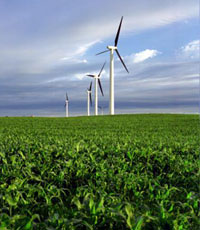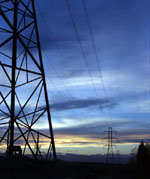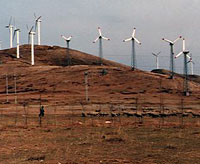Farmers and ranchers in the United States are discovering that they own not only land, but also the wind rights that accompany it. A farmer in Iowa who leases a quarter acre of cropland to the local utility as a site for a wind turbine can typically earn $2,000 a year in royalties from the electricity produced. In a good year, that same plot can produce $100 worth of corn.

Double your pleasure — two different crops.
Photo: NREL/PIX.
Wind turbines strung across a farm at appropriate intervals can provide a welcome boost to farm income, yielding a year-round cash flow. At a time when farmers are struggling with low grain prices, some are now finding salvation in this new “crop,” enabling them to stay on their land. It is like striking oil, except that the wind is never depleted.
In the Great Plains, where an acre of rangeland produces only $20 worth of beef a year or where an acre planted in wheat may yield $120, the attraction of wind power is obvious. For ranchers with prime wind sites, income from wind could easily exceed that from cattle sales.
Harnessing the wind has become increasingly profitable. The American Wind Energy Association reports that the cost per kilowatt-hour of wind-generated electricity has fallen from 38 cents in the early 1980s to 3 to 6 cents today. Already competitive with other sources, the cost of wind-generated electricity is expected to continue to decline. These falling costs, facilitated by advances in wind turbine design, help explain why wind power is expanding rapidly beyond its original stronghold in California.
As wind farms have come into operation in farming and ranching states such as Iowa, Minnesota, Texas, and Wyoming, wind electric generation has soared, pushing U.S. wind-generating capacity from 1,928 megawatts in 1998 to 2,490 megawatts in 1999 — a gain of 29 percent. The potential of wind power is enormous. A U.S. Department of Energy wind resource inventory found that three states — North Dakota, Kansas, and Texas — have enough harnessable wind energy to meet electricity needs for the whole country.
Blow by Blow
One of the attractions of wind energy is that the turbines scattered across a farm or ranch do not interfere with the use of the land for farming or cattle grazing. Farmers can literally have their cake and eat it too.

A high-powered crop.
Photo: NREL/PIX.
Another attraction is that much of the income generated stays in local communitities, whereas the money spent for electricity from an oil-fired power plant may go to the Middle East. With a single large turbine generating $100,000 or more worth of electricity per year, harnessing local wind energy can revitalize rural communities.
Agricultural land values may soon reflect this new source of income. The wind meteorologist who identifies the best sites for turbines is playing a role in the emerging new energy economy comparable to that of the petroleum geologist in the old energy economy. The mere sight of a wind meteorologist installing wind-measuring instruments in a community could raise land prices.
And it is not only the wind farms themselves that provide income, jobs, and tax revenue. The first utility-scale wind-turbine manufacturing facility outside of California recently started operation in Champaign, Ill., the heart of the Corn Belt.
Cheap electricity produced from wind can also be used to electrolyze water, thereby producing hydrogen, which is now widely viewed as the fuel of the future. With automobiles powered by fuel-cell engines expected on the market within a few years, and with hydrogen as the fuel of choice for these engines, a huge new market is opening up. Royal Dutch Shell, a leader in this area, is already starting to open hydrogen stations in Europe.
Farms and ranches may one day supply the hydrogen that will power the nation’s motor vehicle fleet, giving the U.S. the energy source needed to declare its independence from Middle Eastern oil.
The Answer, My Friend, Is Blowin’ in the Wind
As concerns rise about the burning of fuels that destabilize the climate, governments at all levels are beginning to encourage the development of climate-benign renewable energy sources. In some states, utility commissions are requiring utilities to offer their customers a “green power” option. Although this usually means a slightly higher monthly electricity bill, many citizens worried about climate change are choosing green power.

Do you know where your power comes from?
Photo: NREL/PIX.
In Colorado, a wind power option available to both residential and business electricity users has already led to the installation of 20 megawatts of wind-generating capacity — an amount expected to double soon. Minnesota is requiring its largest utility to install 425 megawatts of wind-generating capacity by 2002. In Texas, the legislature has set a goal of 2,000 megawatts of generating capacity from renewable sources by 2009, with most of that expected to come from the Lone Star State’s abundant wind resources.
At the national level, U.S. Secretary of Energy Bill Richardson is requiring that 7.5 percent of the electricity used by his department come from non-hydro renewable sources by 2010.
A formidable new alliance is emerging in support of wind energy. Farmers and consumers are now joining environmentalists in supporting the development of the nation’s wind wealth. So, too, are political leaders in the farming and ranching states of the Midwest and the Great Plains, many of whom sponsored legislation in Washington to extend the wind energy tax credit, which encourages investment in wind power. Aside from the economic benefits of wind energy, political interest is being spurred by a steady diet of news stories about the possible effects of global warming, including record heat waves and droughts, melting glaciers, and rising sea levels.

Wind power, Mongolia-style.
Photo: William Wallace, NREL/PIX.
Rapid growth in wind energy is not limited to the U.S. Worldwide, wind electric generation in 1999 expanded by a staggering 39 percent. Wind already supplies 10 percent of Denmark’s electricity. In Germany’s northernmost state of Schleswig-Holstein, it supplies some 14 percent of all electricity. Spain’s northern industrial province of Navarra gets 23 percent of its electricity from wind, up from zero just four years ago. In China, which recently opened its first wind farm in Inner Mongolia, wind analysts estimate that the country’s wind potential is sufficient to double national electricity generation.
In Denmark, Germany, and the Netherlands, individual farmers or organized groups of farmers are investing in turbines themselves and selling electricity to the local utilities, thus boosting the farmers’ share of income from wind power.
The world is beginning to recognize wind for what it is — an inexhaustible energy source. Farmers are learning that two crops are better than one, political leaders are realizing that harnessing the wind can contribute to both energy security and climate stability, and consumers are finding out that they can help stabilize the climate. This is a winning combination — one that will help make wind a cornerstone of the new energy economy.


